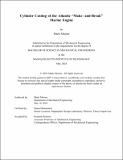| dc.contributor.advisor | Braunstein, Daniel | |
| dc.contributor.author | Mosser, Mark | |
| dc.date.accessioned | 2024-09-03T21:11:02Z | |
| dc.date.available | 2024-09-03T21:11:02Z | |
| dc.date.issued | 2024-05 | |
| dc.date.submitted | 2024-07-10T17:33:33.234Z | |
| dc.identifier.uri | https://hdl.handle.net/1721.1/156605 | |
| dc.description.abstract | The Atlantic “Make-and-Break” Marine Engine was one of the first engines to be mass produced on the Canadian Atlantic coast, and it quickly revolutionized the fishing industry in that area. The Apprentices of Pappalardo lab began a project to make a replica of one of these engines in 2016 to so that they could gain a deeper understanding of sandcasting and how this engine was fabricated. This thesis is a continuation of that project. Students have been fabricating parts for the engine since 2016, and as of Fall 2024 there was one part left to cast: the cylinder. This thesis covers 3 attempts at casting the cylinder for this engine. I will explain the previous work done to cast this part and what I modified from the previous work to make the part easier to cast. I will explain the failure modes that I experienced from the pours, the ways they can be mitigated in the future, and lessons learned for future attempts to cast this cylinder. | |
| dc.publisher | Massachusetts Institute of Technology | |
| dc.rights | In Copyright - Educational Use Permitted | |
| dc.rights | Copyright retained by author(s) | |
| dc.rights.uri | https://rightsstatements.org/page/InC-EDU/1.0/ | |
| dc.title | Cylinder Casting of the Atlantic “Make- and-Break” Marine Engine | |
| dc.type | Thesis | |
| dc.description.degree | S.B. | |
| dc.contributor.department | Massachusetts Institute of Technology. Department of Mechanical Engineering | |
| mit.thesis.degree | Bachelor | |
| thesis.degree.name | Bachelor of Science in Mechanical Engineering | |
